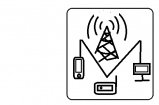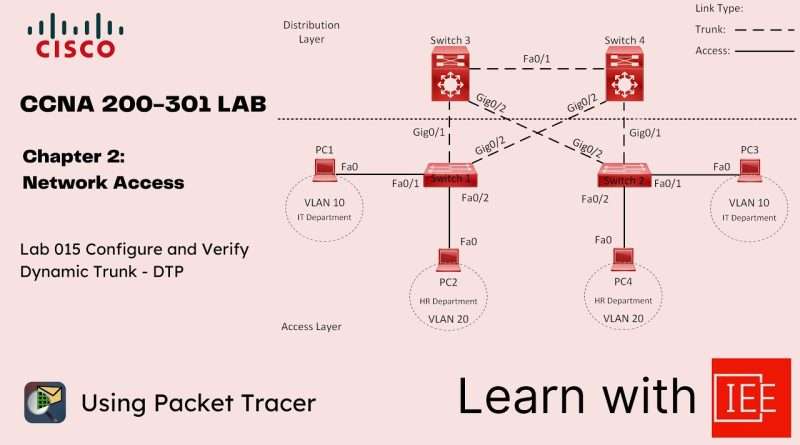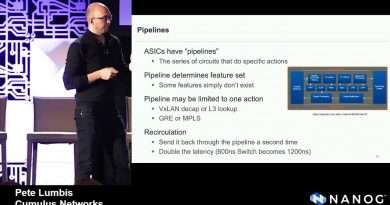CCNA 200-301 Lab | Chapter 2 Network Access | Lab 015 Configure and Verify Dynamic Trunk – DTP
Welcome to our CCNA 200-301 lab series and welcome to today’s comprehensive guide configuring and verifying Dynamic Trunk across multiple Cisco switches.
Trunking plays a crucial role in networking, allowing us to efficiently carry traffic between switches and scale our network infrastructure.
In this video, we’ll dive into the intricacies of Dynamic Trunk configuration using dot1Q encapsulation, exploring the setup process step by step.
By the end of this tutorial, you’ll have a solid understanding of how to configure and verify Dynamic Trunking, empowering you to optimize your network connectivity
Whether you’re a beginner or an experienced network administrator, this video will provide you with valuable insights into setting up efficient and secure networks.
Don’t forget to like, share, and subscribe for more CCNA labs and valuable insights to help you succeed in your Network IT career.
What will you learn:
1- The concept of trunking and its importance in network infrastructure.
2- How to configure Dynamic Trunk links between Cisco switches.
3- Different trunk options such dynamic auto vs dynamic desirable.
4- Verification techniques to ensure proper trunk configuration.
5- Troubleshooting methods for trunking issues.
6- The role of access and distribution layers in network design.
7- Best practices for trunk configuration and management.
8- Practical hands-on experience with Cisco switches and trunking technologies.
9- Understanding the impact of trunking on network performance and scalability.
Lab Objective:
This lab aims to demonstrate the configuration of trunk ports to allow the passage of VLAN traffic between switches and devices, ensuring roper connectivity and efficient network segmentation.
Additionally, the objective includes verifying the trunk configuration to confirm correct VLAN propagation and ensure seamless communication between devices in different VLANs.
Through this lab, participants will gain practical experience in configuring and troubleshooting trunk links in a network topology comprising distribution and access layer switches.
Here is the link for how to Configure Static Trunk on multiple Cisco Switches:
Lab Info:
Lab Tasks, Topology and Lab Solution can be found in the link below:
https://drive.google.com/file/d/1gBq6zgb2H-mGY47w9x8u809J7F9TRw52/view?usp=sharing
Packet Tracer Lab (Pre-configuration) URL:
https://drive.google.com/file/d/1BPjh9UqNsOBbdtteXz2HYYzIn73jS24q/view?usp=sharing
Packet Tracer Lab (Post-configuration) URL:
https://drive.google.com/file/d/1rZTT2Jxbl0a7rBlSUdlYFwLryRnyUptx/view?usp=sharing
Equipment Required:
• 2 L3 Switches (e.g., WS-C3560-24PS-E)
• 2 Cisco switch (e.g., WS-C2960-24TT-L)
• 4 PCs or laptops with Ethernet ports (for data traffic)
• Console cables for Routers
• Ethernet cables for connections between devices
• Computer with Terminal emulation software e.g. PuTTY
Switch VLAN Table:
Please refer back to the lab document above.
SVI Table:
Please refer back to the lab document above.
Hosts IPv4 Address Table:
Please refer back to the lab document above.
Lab Task:
Please refer back to the lab document above.
Timestamps:
00:05 – Introduction and lab objective
05:10 – Lab Topology – walkthrough
06:50 – Lab Tables – Walkthrough
10:40 – Lab task walkthrough
16:25 – Solution Steps Walkthrough
17:15 – How to configure VLANs on a Cisco Switch
19:25 – How to configure SVI (Switch Virtual Interfaces) on a Cisco Switch
22:30 – How to configure a dynamic trunk using dynamic auto option on a Cisco Switch
27:35 – How to configure the native VLAN on a trunk
29:30 – How to configure a dynamic trunk using dynamic desirable option on a Cisco Switch
38:20 – How to configure access ports with Data VLANs
42:50 – Connectivity test between PCs in the same VLAN/Network
44:30 – How to enable IP Routing on a Cisco Switch
45:00 – Inter-VLAN connectivity test
45:30 – Conclusion
Conclusion:
In conclusion, configuring and verifying Dynamic trunks is essential for ensuring efficient communication between VLANs in a network environment.
By establishing trunk links between switches and properly configuring trunking parameters such as encapsulation method and allowed VLANs, network administrators can facilitate seamless traffic flow across VLANs while maintaining network segmentation and security.
Through this lab, we have gained valuable hands-on experience in configuring and verifying Dynamic trunks, allowing us to understand the importance of trunking in modern network architectures.
Moving forward, this knowledge will be invaluable as we continue to design, deploy, and manage complex network infrastructures.
#ccna #VLANs_Configuration #ccna_routing_and_switching #packettracer #Dynamic_Trunk #Trunk #handsonlab #ccna_labs #ccnalabs #IT_Network_for_beginners
Views : 446
network engineer




